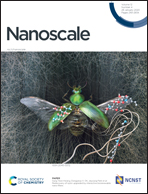NiMn compound nanosheets for electrocatalytic water oxidation: effects of atomic structures and oxidation states†
Abstract
Although Mn-based oxygen evolution clusters in photosystem II show efficient activity in water oxidation, the catalytic performance of artificial Mn-based electrocatalysts is far from satisfactory, which is probably due to the undesirable atomic structure and electronic arrangement of their Mn ions. Aiming to systematically study the performance of two-dimensional (2D) catalysts, we designed and synthesized a series of nanosheets, including NiMn LDH and Ni-birnessite and their morphology-retained annealing products NiMnOx-L and NiMnOx-B, respectively. We comprehensively compared the OER performance of these 2D electrocatalysts in conjunction with the information on their crystalline phases, electronic conductivity, electrochemical surface area and oxidation states of their transition metal ions. It was found that the annealing-converted NiMnOx exhibited 3- and 5-times higher concentrations of catalytically active Mn(III) than the corresponding NiMn LDH and Ni-birnessite precursors. Moreover, the layered atomic structure was beneficial for the charge transfer, leading to faster reaction kinetics. Among the nanosheets tested, NiMnOx-B showed the best alkaline OER performance with the lowest overpotential and the smallest Tafel slope because it not only retained the layered atomic structure and the 2D nanosheet morphology of the Ni-birnessite precursor, but also benefitted from the decreased interlayer distance and more Mn(III) species. This work sheds light on the design of effective non-noble metal-based electrocatalysts towards water oxidation for hydrogen production.



 Please wait while we load your content...
Please wait while we load your content...